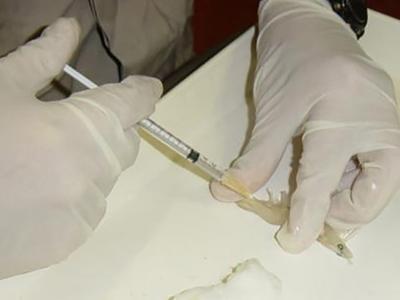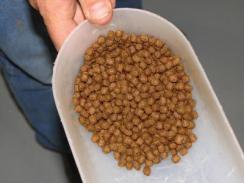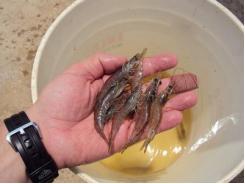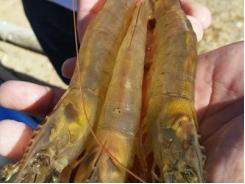Measuring susceptibility differences to IHHNV infection

Trials on three batches of Pacific white shrimp show possible indirect way to assess genetic diversity
Shrimp from the three batches were injected with serial, ten-fold virus stock dilutions to determine their susceptibility to IHHNV infection
First detected in stocks of the Pacific blue shrimp (Litopenaeus stylirostris) in Hawaii in 1980, Infectious Hypodermal and Haematopoietic Necrosis Virus (IHHNV) caused high mortalities in this species and induced the Runt Deformity Syndrome (RDS) in infected Pacific white shrimp (L. vannamei). In Mexico, mortalities caused by IHHNV were so severe that farmers were forced to switch from the widely cultured blue shrimp to the Pacific white shrimp. The latter species soon became the main farmed species.
IHHNV belongs to the virus family Parvoviridae. It is a small (22 nm diameter), icosahedral particle containing a single-stranded DNA molecule of 4075 nucleotides long. At present, IHHNV does not cause high mortalities in farmed populations of blue or white shrimp. On the contrary, recent reports suggest that IHHNV infection may protect shrimp against a subsequent, lethal White Spot Syndrome Virus (WSSV) infection, thus reducing mortality.
The study discussed here is the first part of a broader study leading to confirm the role of IHHNV infection in impairment of WSSV infection. We observed that IHHNV infection was not always achieved using shrimp batches from different hatcheries. Therefore, the aim of our work was to determine the susceptibility to an IHHNV inoculum in Mexican batches of Pacific white shrimp from three different hatcheries and under experimental conditions.
Previous IHHNV studies
Previous studies have indicated susceptibility differences to IHHNV in various shrimp species such as L. vannamei, Penaeus monodon and Farfantepenaeus subtilis using detection methods such as histology, in situ hybridization, PCR, transmission electron microscopy and bioassays. Species such as F. subtilis have low susceptibility to IHHNV, as only a transient infection and low mortalities (≤ 10 percent) were recorded after 10-day post-virus inoculation. In contrast, the other shrimp species showed different degrees of susceptibility to IHHNV.
In 1997, Alcivar-Warren and colleagues determined susceptibility differences to IHHNV and Baculovirus penaei within families of Pacific white shrimp. Five families of high-health shrimp with high or low growth rates were evaluated against IHHNV susceptibility. A relationship between levels of genetic diversity and IHHNV prevalence were determined by polymorphism restriction analysis. Families with lower genetic diversity showed the highest IHHNV prevalence. In contrast, families with the highest genetic diversity showed the lowest IHHNV prevalence.
Study setup
Three batches of Mexican L. vannamei were used to evaluate their susceptibility to an experimental IHHNV infection (Table 1). Shrimp were transported to the laboratory and placed in tanks with a recirculation system. Animals were acclimated to a salinity of 25 g/l, temperature ≤ 30°C and had constant aeration. Thirty shrimp per batch were analyzed by PCR to determine its sanitary status. All batches were initially negative to both IHHNV and WSSV.
Escobedo, Table 1, Feb. 2016
| Batch | Origin | Collection site | Mean body weight at collection (g) |
| 1 | El Rosario, Sinaloa | Granja Aracelitas, Guasave | 1.4 |
| 2 | El Walamo, Sinaloa | El Walamo, Sinaloa | 0.7 |
| 3 | Nayarit, Mexico | Acuícola Machado, Guasave | 2.3 |
Hatcheries and origin of the three batches of Pacific white shrimp (Litopenaeus vannamei) used in this study.
During the IHHNV challenge assays shrimp were maintained at 27ºC ± 2ºC, 25 g/L salinity and with constant aeration. Water in the experimental system was exchanged (70%) every week. Each shrimp was fed every day with three feed pellets in the morning and three pellets in the evening.
…recent reports suggest that IHHNV infection may protect shrimp against a subsequent, lethal White Spot Syndrome Virus (WSSV) infection, thus reducing mortality.
An IHHNV inoculum was produced from naturally infected shrimp collected in a local farm, and it was titrated in vivo and stored as previously described by the author and colleagues. Shrimp from the three batches were used to determine the susceptibility to IHHNV infection through in vivo titrations by injecting them with serial, ten-fold virus stock dilutions. The number of infected shrimp per batch was determined at the end of the experiments (15-day post-inoculation) by PCR analyses. PCR was done using IHHNV primers (IHHNV392F and IHHNV392R) under specific amplification conditions as designed in 2000 by Tang and colleagues to detect IHHNV infection in postlarvae and juvenile blue shrimp. PCR products were resolved in an agarose gel electrophoresis and visualized in a UV transilluminator. IHHNV infection data were used to determine the infectivity titer (SID50/ml) for each batch, which in turn was used to define the susceptibility to IHHNV.

View of the experimental units used in the study.
Results
Shrimp from each batch were evaluated for IHHNV susceptibility at two different stages: early (≤ 4.0 g) and late (≥ 8.0 g) juveniles. In batch 1, infectivity titers for early and late juvenile shrimp were 105.2 SID50/ml and 104.6 SID50/ml, respectively. In Batch 2, infectivity titers for both sizes were < 101.5 SID50/ml, since none shrimp of the two sizes became infected with any of the IHHNV dilutions. Early and late juvenile from Batch 3 had an infectivity titer of 103.6 SID50/ml and 102.2 SID50/ml, respectively. Batch 1 showed the highest susceptibility to IHHNV infection, followed by Batch 3 and Batch 2. (Table 2).
Escobedo, Table 2, Feb. 2016
| Batch | Mean weight (g) | Dilutions | Inoculated shrimp per diltution | Infectivity titer | IHHNV susceptibility |
| 1 | 3.2 ± 0.78 10.5 ± 0.85 | 10-1 to 10-5 10-1 to 10-5 | 5 5 | 105.2 SID50/ml 104.6 SID50/ml | 1 |
| 2 | 2.9 ± 0.48 8.9 ± 0.76 | 10-1 to 10-5 10-1 to 10-5 | 5 5 | < 101.5 SID50/ml < 101.5 SID50/ml | 3 |
| 3 | 3.1 ± 0.59 g 7.9 ± 0.33 g | 10-1 to 10-5 10-1 to 10-5 | 5 5 | 103.6 SID50/ml 102.2 SID50/ml | 2 |
IHHNV infectivity titers and susceptibility rank of three batches of Pacific white shrimp Litopenaeus vannamei.
Although it was not possible to use markers to determine the genetic makeup of the batches used in the present study, it was assumed that each batch had different genetic diversity. The fact that each batch came from a different hatchery located at least one-hundred kilometers away from each other and that each batch was produced from a different brooder stock makes it a plausible hypothesis. Once in the laboratory, the three shrimp batches were maintained under the same controlled environmental conditions (temperature, salinity and aeration) and the same IHHNV isolate was used. Therefore, shrimp origin was the variable that explained the susceptibility differences found in this study.
…shrimp origin was the variable that explained the susceptibility differences found in this study.
Our results suggest that the batch with higher susceptibility to IHHNV infection may have lower genetic diversity, whereas the least susceptible batch may have higher genetic diversity. This is consistent with earlier research by Alcivar-Warren and colleagues (1999), who worked with families of the Pacific white shrimp and reported that the more diverse the genetic makeup of shrimp, the lower its susceptibility to a pathogen.

Naturally infected shrimp collected at a local farm were used to produce an IHHNV inoculum for the study.
Host susceptibility to a virus is important since it may influence virological traits such as speed of virus replication, pathogenicity and virulence. These features determine viral pathogenesis and the outcome of infection. Factors mentioned to determine differences in host susceptibility to a pathogen include genetic diversity, age, size, water quality and pathogen persistence.
Perspectives
This study evaluated the susceptibility to IHHNV of three different shrimp batches by measuring infectivity titers. Here, infectivity titers were a measure of virus susceptibility. This method may be an indirect way to assess genetic diversity of a shrimp batch. Further studies are needed to confirm that IHHNV susceptibility may be an indicator of the reduced genetic diversity and/or endogamy of shrimp batches and/or families
Cesar M. Escobedo-Bonilla, Ph.D.
- Centro Interdisciplinario de Investigación para el Desarrollo Integral Regional
- Instituto Politécnico Nacional
- Unidad Sinaloa
- Blvd. Juan de Dios Batiz Paredes 250
- Colonia San Joachin, Guasave
- Sinaloa 81101 México
Related news
Tools

Phối trộn thức ăn chăn nuôi

Pha dung dịch thủy canh

Định mức cho tôm ăn

Phối trộn phân bón NPK

Xác định tỷ lệ tôm sống

Chuyển đổi đơn vị phân bón

Xác định công suất sục khí

Chuyển đổi đơn vị tôm

Tính diện tích nhà kính

Tính thể tích ao




 Feed tray management lowers FCRs, shrimp production costs…
Feed tray management lowers FCRs, shrimp production costs…  Microencapsulated organic acids aid shrimp culture
Microencapsulated organic acids aid shrimp culture